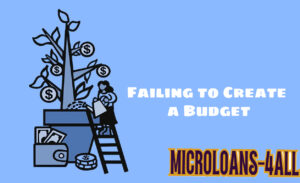
Hello, friends. Welcome to our blog. My name is Max, and if this is your first time visiting our blog, please bookmark it, as we will continually share articles that benefit you and your business. Always make sure to visit our blog from time to time for important articles, such as what we are about to share now.
Common Budgeting Mistakes to Avoid (Especially in Your 20s)
Personal finance advice for young adults is crucial, yet often overlooked. With only 35% of young adults tracking expenses and most Americans unable to handle $1,000 emergencies, financial literacy is essential.
Many young adults make financial mistakes due to poor planning, with the average household carrying $7,000 in credit card debt. Simply checking bank balances before spending isn’t enough.
This article explores common budgeting mistakes and solutions to build financial stability, starting with understanding what’s holding you back.
-
Failing to Create a Budget

One of the most pervasive personal finance mistakes occurs when young adults operate without a financial roadmap. According to a 2020 Intuit survey, more than 60% of people didn’t know how much money they spent the previous month. This lack of awareness creates a dangerous financial blind spot, especially during your formative financial years.
-
Not Having a Budget
Not Having a Budget Explanation
A budget is a written plan that tracks your monthly income and expenses. While it seems straightforward, not budgeting can have serious financial consequences.
Living without a budget is risky, like driving blindfolded. Without tracking expenses, you might run out of money and miss chances to save for important goals.
-
Not budgeting can lead to:
Persistent overspending: Guessing instead of tracking often means spending more than you earn
Emergency unpreparedness: Most people can’t cover even a $1,000 unexpected expense
-
Damaging Your Credit Without Realizing It
- High credit utilization from unplanned spending can lower your credit score.
- Financial stress affects most adults, with money being a major concern.
- Without budgeting, saving for life goals becomes challenging.
- Tracking expenses is crucial regardless of income level.
-
What Happens When You Don’t Budget: True Example
Consider Alex, a 24-year-old marketing associate earning $48,000 annually. After taxes and health insurance, Alex takes home approximately $3,000 monthly. Though initially feeling financially comfortable, Alex frequently finds his bank account nearly empty several days before payday.
When prompted to explain where the money goes, Alex can only account for major expenses: $1,200 for rent, $300 for car payment, and about $400 for groceries. The remaining $1,100 disappears into what financial advisors often call the “black hole” of untracked spending.
What Alex doesn’t realize is that daily coffee purchases ($120/month), subscription services he rarely uses ($85/month), frequent food delivery ($200/month), and impulse online shopping ($250/month) consume a significant portion of his income. Furthermore, without an emergency fund, when his car needed unexpected repairs costing $800, Alex had to use a credit card and is now paying additional interest.
After six months of this pattern, Alex has accumulated $2,500 in credit card debt despite earning what should be a sufficient salary. Meanwhile, his student loans remain untouched, and the idea of saving for a home down payment feels increasingly unrealistic.
Common Budgeting Mistakes to Avoid (Especially in Your 20s)
This scenario illustrates how even a decent income can quickly become inadequate without proper budgeting. Furthermore, since Alex is budgeting based on his gross pay rather than his take-home amount, he consistently overestimates how much money he has available to spend.
-
Not Having a Budget: How to Fix It
Creating an effective budget is essential for financial wellness, especially when starting in your 20s. Here’s how to begin:
- Assess your net income
Focus on take-home pay after taxes and deductions. Track irregular income carefully if freelancing.
Track all expenses for one month. Record every purchase using apps, spreadsheets, or paper. Review bank statements for categories.
- Categorize your spending
Separate fixed costs (rent, utilities) from variable expenses (groceries, entertainment). Set a financial goal.s Define short-term (emergency fund) and long-term objectives (retirement).
- Create a realistic spending plan.
Follow the 50/30/20 rule 50% needs, 30% wants, 20% savings/debt.
- Automate your savings
Set up recurring transfers to a separate emergency account.
- Adjust regularly
Review your budget quarterly or when life changes occur. Remember, budgeting gives you control over money while allowing for enjoyable spending. Though initially challenging, consistent budgeting can help build a six-week emergency fund enough to handle temporary financial difficulties.
-
Ignoring Small, Recurring Expenses
The money management practices established during your third decade often shape your financial future. One of the most dangerous threats to your monetary well-being comes from minor, repetitive costs that steadily deplete your resources while operating beneath your daily financial radar.
Overlooking Regular, Minor Expenses
Overlooking Regular, Minor Expenses: Explanation
Recurring small costs are those regular expenditures that seem minimal when viewed individually but create substantial financial drain when combined. These encompass streaming platforms, everyday beverage purchases, delivery charges, and other routine payments that either auto-renew or happen frequently enough to become normalized.
These expenditures prove especially harmful because of their subtle nature. A daily $5 beverage purchase may seem trivial, but it accumulates to roughly $1,800 yearly. Research shows that typical households allocate approximately $219 monthly toward subscription services. This “subscription accumulation” the steady increase in monthly service commitments—typically occurs unconsciously as new services are added without evaluating their continued worth.
The mental component is significant here. Since individual charges appear manageable, your mind fails to identify them as financial risks. However, these expenses generate what experts term “subscription exhaustion,” mounting stress from juggling multiple services that collectively burden your finances.
Examine these typical categories of recurring costs that often escape scrutiny:
- Online subscriptions: Video platforms, data storage, premium applications, and media access
- Organization dues: Exercise facilities, social clubs, and industry associations
- Regular purchases: Beverage runs, snack purchases, and quick-stop shopping
- Service subscriptions: Meal delivery platforms, product boxes, and scheduled shipments
The situation worsens when considering “concealed costs” linked to these expenses, automatic renewals at higher prices, hidden transaction fees, and inactive subscriptions that continue billing.
Overlooking Regular, Minor Expenses: Real-world example
Sarah, a 26-year-old in communications, considers herself financially prudent. She maintains timely rent payments, invests in her retirement account, and resists major spontaneous purchases. However, she consistently discovers her monthly balance is lower than anticipated.
After analyzing her spending, Jordan discovers she’s spending on:
Five streaming services totaling $65 monthly (including two she rarely watches)
A $40 monthly gym membership you use just once or twice
Food delivery services average $200 monthly
A premium app subscription for $4.99 monthly, she forgot she had
Daily coffee shop visits average $120 monthly
All told, these expenses amount to over $5,000 annually—enough for a substantial emergency fund or investment start. Furthermore, many of these services auto-renew, meaning Jordan continues paying for them long after they stop providing value.
What’s particularly concerning is that Jordan isn’t alone—30% of Gen Z and millennials pay for streaming subscriptions they don’t even use. On top of that, 31% of millennials report that food delivery orders are a regular source of wasteful spending. This pattern of unconscious spending creates a significant obstacle to achieving financial goals.
Ignoring Small, Recurring Expenses: How to Fix It
Tackling recurring expenses requires awareness and strategic action. Here’s a systematic approach to regain control:
1. Conduct a subscription audit. First thing to remember, you must identify every recurring charge on your accounts. Review your credit card and bank statements for the past six months, noting every subscription and recurring purchase. Many people discover they’re paying for services they forgot they signed up for or no longer use. Several financial apps can automatically track these expenses and categorize them for easier analysis.
2. Categorize and evaluate each expense. After identifying all subscriptions, assess each one by asking:
How often do I use this service?
Does the value received justify the cost?
Could I find a free or cheaper alternative?
Am I paying for overlapping services that serve similar purposes?
3. Consolidate and eliminate. Look for opportunities to bundle services or eliminate redundancies. For instance, instead of maintaining multiple streaming subscriptions simultaneously, consider rotating through them—subscribe to one for a month, then switch to another. As a result, you’ll still enjoy content while reducing monthly costs.
4. Negotiate better rates. Many service providers offer discounts when you call and express interest in canceling. Additionally, family plans for music streaming services and other subscriptions can significantly reduce per-person costs. Don’t hesitate to call providers directly and ask for better terms, especially for loyal customers.
5. Implement mindful spending practices. Above all, develop awareness around small purchases. Before making a recurring purchase, calculate its annual cost. That $10 monthly app subscription represents a $120 annual commitment. Is it truly worth that investment?
Common Budgeting Mistakes to Avoid (Especially in Your 20s)
6. Automate tracking. Use expense tracking apps connected to your accounts to monitor recurring charges. These tools can alert you to price increases and help identify opportunities for cutting costs. At the same time, consider using a single card for all subscription services to simplify tracking.
7. Schedule regular reviews. Set calendar reminders to review your subscriptions quarterly. Services that were valuable months ago might no longer serve your needs. Besides, periodic reviews help you catch price increases that often slip through unnoticed.
By implementing these strategies, you can potentially redirect hundreds or even thousands of dollars annually toward meaningful financial goals like debt reduction, emergency savings, or investments, setting yourself up for greater financial freedom throughout your twenties and beyond.
Budgeting Based on Gross Pay Instead of Take-Home

One mistake that many young professionals often make is not grasping the difference between gross and net income when setting up their budgets. It might seem like a small detail, but this misunderstanding can really shake up your financial foundation. It’s surprising how often this crucial piece of personal finance advice slips under the radar for young adults.
Budgeting Based on Gross Pay Instead of Take-Home
Budgeting Based on Gross Pay: Explanation
Gross pay represents the total amount you earn before any deductions are taken out. On the other hand, net pay is what lands in your pocket after accounting for taxes, benefits, and other withholdings like:
Income taxes (federal, state, local)
Social Security and Medicare taxes
Health insurance premiums
Retirement contributions
HSA contributions
Student loan payments
YOUR Seven money mistakes to avoid in your 20sEXT
YOUR TEHow to Start a Finance Blog: Key Tips for BeginnersXT
For someone earning a $50,000 salary, the take-home pay can end up being around $15,710 less each year after all the deductions are taken into account.
Let’s look at a real-world budgeting example. Maya, who works as a marketing coordinator and makes $60,000 a year, bases her budget on her monthly gross income of $5,000.
Common Budgeting Mistakes to Avoid (Especially in Your 20s)
$1,800 for housing
$600 for car expenses
$700 for food
$500 for student loans
$400 for discretionary spending
$1,000 for savings
- However, her actual take-home is only $3,800, leaving her $1,200 short monthly.
- Budgeting Based on Gross Pay: How to Fix It
- The solution is to budget based on net income instead of gross pay.
- Identify your true take-home pay.
Take a moment to go through your pay stubs and get a clear picture of your net income after all deductions. If your earnings fluctuate, try averaging your income over the past 3 to 6 months to get a more stable figure.
Next, it’s important to understand where your deductions are going. Look closely at each item on your pay stub. If you regularly receive large refunds, particularly those exceeding $3,200, consider adjusting your tax withholdings.
If necessary, take advantage of the IRS withholding estimator to figure out a more accurate amount to withhold from your paycheck. This way, you can ensure that you have more cash available each month rather than waiting for a big refund down the line.
Once you have a solid grasp on your net income, create a zero-based budget. Make sure every dollar of your take-home pay is accounted for, excluding expenses that are already deducted, like retirement contributions.
Track your spending against your net income. Use budgeting apps or simple spreadsheets to keep an eye on where your money is going. This will help you catch any issues before they become bigger problems.
You might also want to keep track of your gross income separately. While it’s useful to base your daily budget on net income, knowing your gross income can give you a clearer picture of your total compensation. Just remember, budgeting with gross income might lead to overspending, as many of those funds are already committed to taxes and benefits. Focusing on net income helps you maintain a realistic financial outlook.
Keep in mind that gross income reflects your earning potential, but net income is what you have to work with daily. Understanding this difference is crucial for developing sustainable financial habits.
Common Budgeting Mistakes to Avoid (Especially in Your 20s)
Making financial missteps in your twenties can have a long-lasting impact. Many common budgeting issues arise from not having a solid plan, underestimating expenses, budgeting with gross income, setting unrealistic goals, or not tracking spending effectively. Start implementing small changes now, and you’ll see significant benefits down the road.
Research suggests that maintaining an emergency fund to cover 3 to 6 months of expenses is key to safeguarding yourself against unexpected financial challenges. Avoiding common budgeting mistakes can make this goal much more achievable.
Lastly, remember that financial literacy grows with practice and learning from your missteps. Don’t let past mistakes bring you down; embrace them as valuable lessons.
The financial habits you cultivate today will shape the opportunities available to you tomorrow. Smart budgeting is your ally on the path to long-term financial freedom.



